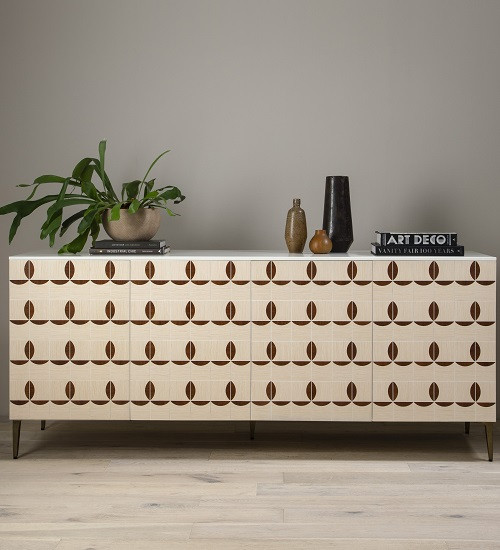Tracey Boyd Furniture Available at Zin Home
Posted by Zin Home on 24th Oct 2019
Furniture Talk with Renounced Designer Tracey Boyd
Inspired by her travels across India, Singapore and beyond, designer Tracey Boyd’s collection blends a creative treatment of materials and shape to stunning effect. Together, Boyd’s artisanal craftsmanship, instinctual finesse and fresh use of color place a modish spin on lifestyle furniture. We recently spoke with the former fashion designer about her inspiration, process and personal favorites from the new collection
Color seems to play a major role in your furniture pieces...
Color – and texture – rule over my designs more than anything, because they add interest without shouting out. So, something like the beautiful green bird’s eye maple is a simple shape, but it has that lovely contrast of wood in a heavy oblong plinth with beautifully curved brass; the two colors and shapes work well in complementary ways. A curve and sharp edge juxtaposition, masculine and feminine.
When approaching a new design, what do you consider first?
I design with balance in mind, starting with a simple shape before adding embroidery or marquetry. I approach a fashion design the same way, it's like framing a beautiful detail.
Do you have any personal favorites from the collection?
I love the Skate Dining Table because I hadn’t done any large-scale wood pieces. I love the chunkiness and different directions of woods, and that it’s based on a giant skateboard! I also love the Atrumed Stools with dimples. They’re so cute I’d like to get some for my own house!
First fashion, now furniture… Does design come naturally to you?
Well, the “first step” is instinctual. Something will jump out at me, then I compile ideas around that. Something like the Trefoil Sideboard, for example, started with my love of flowers and nature. I like taking shapes from nature and turning them into more graphic form. [My husband and I] just bought a cottage in the country, which we’ve been renovating. We have a beautiful clover field there, so I was looking at all the leaves and thinking how lovely the shape would be for marquetry. I start thinking of colors and textures to use from there, and I think the effect is lovely on that piece in particular.
What activities do you enjoy in addition to designing?
I love collecting! I’m an avid artisan and flea market goer. I love going to botanical museums and folk-art museums... I appreciate the decorative side of things in general.
Would you say that collector’s side of you influences your designs?
Maybe not day-of, but definitely down the line. I take hundreds of pictures, buy lots of vintage books, and compile files of things that interest me. Then, when I’m ready to design I go through those folders and ask myself, “What do I like best about this, who will buy this, would I buy this?” Because there’s no point in designing something no one will buy!
In which direction do you see the industry currently moving?
Design had been glossy for a while, but is now moving toward a more natural feel, with big, chunky shapes and lots of texture. It’s reflective of how people are wanting to live nowadays, with organic farming and artisan-led movements.
How hands-on are you in the production process?
I feel strongly that it’s important for me to be present and work with the factories, as there’s always a learning curve. While they were carving the Atrumed Stools, for example, I was there watching technique, looking at everything and realizing, “Actually, this needs to look more like that.” Sometimes, they may take a piece in the wrong direction, but it looks even better than how it was supposed to be— you miss something like that if you’re not present. It’s a collaborative relationship.
Your pieces with bird’s eye maple look especially novel.
Yes, I’m always looking for something new. I liked the idea of its organic pattern— graphic-looking but still natural, as it’s not completely uniform. We started with this pale green terrazzo at first, but it was proving difficult. In collaboration, we agreed to use an emerald dye stain to lend more richness to the material. When using wood veneer, every piece is slightly different, so it has its own character, which can’t be beat.





